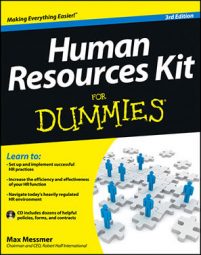Bad hiring decisions in any business rarely happen by accident. In retrospect, you can usually discover that you didn’t do something you should have in making your decision.
Anchor yourself to the hiring criteria
The hiring criteria that you establish from the beginning should serve as your strict guide throughout the evaluation process. If, in looking ahead, you decide to change the criteria, fine. Just make sure that you aren’t changing criteria simply because you’re enamored with one particular prospect and decide to change the ground rules to accommodate that candidate.
Anchoring yourself to hiring criteria helps to prevent three of the most common pitfalls in hiring:
The halo effect: Becoming so enraptured by one particular aspect of the candidate — appearance, credentials, or interests, for instance — that you let that aspect influence all your other judgments
The cloning effect: Hiring someone in your image even though someone with your particular mix of skills and attributes clearly isn’t qualified for that particular job
How much you “like” the candidate
Take your time
The more pressure you’re under, the greater the likelihood of rushing the decision and ending up with someone who not only isn’t your best choice but you’re probably going to end up firing — with all the disruption that firing someone entails.
Keep in mind the main pitfall of acting out of urgency: You overestimate the qualities of candidates who may be only marginally qualified to fill the job. If you’re worried about finding someone right away, see whether you can bring in a temporary replacement to keep projects on track as you continue the search.
Cross-verify whenever possible
Whatever else they may disagree on, most hiring experts contend that you can never have enough information from enough different sources. So, try not to rely solely on any one source, whether interview impressions, résumé data, reference checks, or testing. Cast a wide net and pay careful attention to discrepancies.
Get help, but avoid too much help
A smart practice — particularly when filling a key position — is to get input from others before you make a final choice. Involving too many people in the final decision, however, is a mistake. If too many people have a say, the likely outcome is a compromise choice. Instead of getting the best employee, you end up with the candidate who’s the least objectionable to everyone.
Try to restrict your circle of decision makers to three to five people who understand the job, your company’s culture, and the personality and working style of the potential hire’s manager. You can gain these additional perspectives on candidates by holding multiple and panel interviews. When it comes time for the final decision, these same people can help you choose the best applicant.
Don’t force the issue
The recruiting process sometimes uncovers a “dream” employee — except for one problem: The candidate’s skills and attributes don’t match the hiring criteria of a particular job.
The best thing to do if you find yourself in this situation is to see whether you can find another job in the company that better suits this particular candidate. The worst thing that you can do is try to put a good worker in the wrong job.
Avoid the “top of mind” syndrome
Do your best to stay alert to any extraneous factors that may distort the selection process. Employers tend to choose some candidates over others, for example, not because those candidates are more qualified but because they’re interviewed later in the hiring process and are fresher in the minds of the interviewer. The best way to avoid this pitfall is to keep your focus on the hiring criteria, no matter what.

